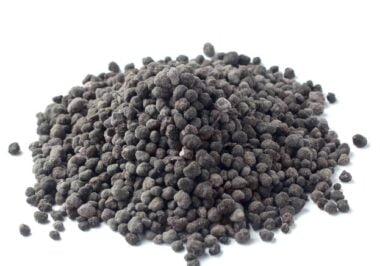
The beautiful blooms of hibiscus are delight to eye both inside and outside the home. Which makes it all the more important to provide them with the right nourishment.
It is for this very reason that we are here to answer one of the most frequently asked question: DAP and its effects on hibiscus.
What Is DAP?
Nitrogen-containing phosphate fertilizers such as Diammonium phosphate (NH4)2HPO4 is produced from ammonia and phosphoric acid. DAP is a light brown, granulated phosphate-nitrogen fertilizer or in other words a plant food rich in the mineral phosphorus.
It has 46% Phosphorus P2O5 and 18% Nitrogen in the form of ammonium (NH4) which is gradually converted into nitrate in the soil and made available to plants.
Nitrate is immediately absorbed by the plant and quickly leads to growth success. The effect of this fertilizer can be observed after 24-36 hours and lasts up to two weeks.

DAP is used primarily as a fertilizer on Potassium-rich soils or as a supplement along with Potash fertilizers. Moreover, DAP is generally added to potash-rich gardens to improve the overall
well being of the plants, or is mixed in small quantities with other fertilizers and micro-nutrients for indoor gardening.
While fertilizing with DAP, the nitrogen requirement in the soil is determined beforehand in order to avoid over-fertilization. This is because fertilizing with DAP posses certain risks of burning (especially plants grown in pots) due to over-fertilization, as well as pollution to the environment through nitrate leaching.
This is why many gardeners choose to mix this type of plant food with other fertilizers to meet the specific needs of their plants and soil. And thus applied in a variety of ways before, during or after the plant has bloomed.
Overfertilization in extreme cases can kill the plant by plasmolysis.
Does My Hibiscus Need DAP?
For flowers to bloom all year round, your hibiscus needs a variety of nutrients. These are taken from the soil that surrounds the roots. A regular supply of these nutrients is therefore essential, especially for plants grown in pots since the nutrients in the soil are simply not enough.
But even for Hibiscus plants that are grown in the garden, the natural supply of nutrients is usually not sufficient to maintain the food supply for years. This is why, in addition to water and sunlight, you will need to fertilize your plants adequately.
However, Hibiscus, with their complex, colorful, huge flowers need more potassium. Which is in fact true for any plant that produces more flowers. And since DAP or Diammonium Phosphate contains only Nitrogen and Phosphorus, it alone will not yield any results.
Moreover, excess of DAP may either cause your Hibiscus to grow excessively without producing any blooms, or might completely kill them since excess of Phosphorous will prevent your plant to absorb other essential nutrients.
Furthermore, volatile ammonia released from DAP can potentially damage the young plants in its immediate proximity. Plus, it is known to disbalance the pH level of the soil to some extent.
In short, DAP leads to a higher localized pH in the soil, thereby hindering the overall growth process as the Hibiscus plant favors slightly acidic soil.
So, if you are planning to add DAP to your Hibiscus, make sure you are using it in small quantitates along with a Potash rich fertilizer. Typically, we recommend a composition that has a medium level of Nitrogen, a low level of Phosphorous, and a high level of Potassium along with other micro-nutrients that are required for their overall wellbeing.
Will DAP Help My Hibiscus To Bloom?
DAP fertilizer when used on a Potash rich soil will help the Hibiscus plant to grow greener and faster. This fertilizer when mixed with other vital micro-nutrients will enhance the flowering process. In addition to that, it promotes the growth of shoots / leaves and improves the overall appearance of the plant.
Advantages Of Using DAP On Hibiscus:
1. Provides a source of phosphorus in phosphate form, accompanied by nitrogen
2. Nitrogen is in ammonium form, which is readily-available for plant uptake
3. Yields results instantly
Drawbacks Of Using DAP On Hibiscus:
1. A notable property of DAP is the alkaline pH that develops around the dissolving granule, which can hinder nutrient uptake under certain soil conditions
2. Excessive use of DAP reduces Hibiscus’s ability to take up required micronutrients, particularly iron and zinc, even when soil tests show there are adequate amounts of those nutrients in it.
How Much DAP Is Needed For My Hibiscus Plant?
DAP is a highly concentrated fertilizer, it is therefore used as a quick release formula. Your plants will be supplied with Nitrogen and Phosphorous in the shortest possible time. This can yield results if your plant is showing signs of nutritional deficiencies. However, if the wrong dosage is used, these benefits will quickly lead to havoc due to over-fertilization.
Depending on your geographical location, you may need to fertilize your hibiscus with DAP about once every 30 days during the growing season. But make sure you are not using DAP alone to do so as they might disturb the overall growth of your plant.
A mixture of DAP along with essential micro-nutrients and Potassium rich fertilizer should be added in small quantities (1/2 – 1 teaspoon) for the first few months. If you are unable to find this exact formulation, always adjust the composition yourself.
For a 12-inch pot, we recommend a total mixture of not more than 5 grams of DAP mixed together with Potassium rich fertilizer and other essential micro-nutrients. You may need to decrease this quantity to half in case of smaller sized pot.
Do note however, in case your plant is growing in a garden, we do not recommend going beyond this recommended dosage (5 grams).
If after application, you observe good results and an increase in the number of blooms, you can continue with the same dosage. However, if you find that the plant has stopped producing
blooms altogether or is showing signs of trauma (brown leaves, shedding, partial flowering), then you must stop the usage of DAP altogether.
Subsequently, you should also stop using any other fertilizer for at least 2 weeks and spray filtered mineral water on the leaves to revive it back to its original form.
Conclusion: Is DAP Good For Hibiscus?
DAP alone is not at all recommended for Hibiscus. You will need to create a perfect balance between the amount of Nitrogen, Phosphorous, and Potassium that is supplied to your plant.
Ideally, it is recommended to create a mix that has medium levels of Nitrogen, low levels of Phosphorous and high levels of Potassium. And since DAP consists of high level of Phosphate and low level of Nitrogen, it should be mixed along with fertilizers like Potassium Nitrate to create an ideal mix.
But don’t forget: for small pots a combined mixture of this composition should not exceed over 2.5 grams. Likewise, for a large pot (~12 inches), do not add more than 5 grams to your plants.
Gardening Tip – Why take chances with synthetic fertilizers when you can nourish your plants with organic nutrients? Forget about DAP and switch to vermicompost to give your hibiscus a boost of benefits!
Happy gardening.





